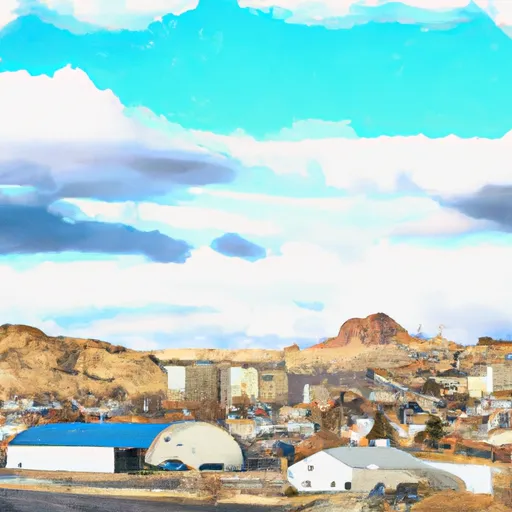-
 Snoflo Premium
Snoflo Premium
Get unlimited access to all our content
With no Ad interruptions! - Start Your Free Trial Login with existing account
Jackpot
Eden Index
Climate
7.2
•
Recreation
•
Community
•
Safeguard
2.9/10

Located in northeastern Nevada, Jackpot is a small town known for its vibrant casino scene and outdoor recreational opportunities. The town experiences a semi-arid climate, with hot, dry summers and cold winters. Average temperatures range from 20°F (-6.7°C) in winter to 90°F (32.2°C) in summer. Precipitation is scarce, with an annual average of 7 inches (17.8 cm), mostly occurring as snow during winter months.
Hydrologically, Jackpot is situated in close proximity to the Salmon Falls Creek Reservoir and the lower Snake River. These water bodies provide opportunities for fishing, boating, and other water sports. Anglers can try their luck catching trout, bass, and catfish in the reservoir and nearby rivers.
The region surrounding Jackpot offers numerous outdoor recreation opportunities. Jarbidge Wilderness, located within the Humboldt-Toiyabe National Forest, is popular for hiking, camping, and wildlife viewing. The area's diverse landscapes include rugged canyons, alpine meadows, and mountain peaks, attracting outdoor enthusiasts and nature lovers. Additionally, the nearby Ruby Mountains offer opportunities for hiking, hunting, and camping, with scenic trails and picturesque lakes.
In summary, Jackpot, Nevada offers a semi-arid climate, limited precipitation, access to water bodies for fishing and boating, and nearby outdoor recreation opportunities such as hiking, camping, and wildlife viewing in the Jarbidge Wilderness and Ruby Mountains.
What is the Eden Index?
The Snoflo Eden Index serves as a comprehensive rating system for regions, evaluating their desirability through a holistic assessment of climate health, outdoor recreation opportunities, and natural disaster risk, acknowledging the profound impact of these factors on livability and well-being.
Climate Health Indicator (CHI): 7.2
Jackpot receives approximately
521mm of rain per year,
with humidity levels near 68%
and air temperatures averaging around
6°C.
Jackpot has a plant hardyness factor of
5, meaning
plants and agriculture in this region thrive during a short period during spring and early summer. Most
plants will die off during the colder winter months.
By considering the ideal temperature range, reliable water supplies, clean air, and stable seasonal rain or snowpacks, the Climate Health Indicator (CHI) underscores the significance of a healthy climate as the foundation for quality living.
A healthy climate is paramount for ensuring a high quality of life and livability in a region, fostering both physical well-being and environmental harmony. This can be characterized by ideal temperatures, reliable access to water supplies, clean air, and consistent seasonal rain or snowpacks.
Weather Forecast
Streamflow Conditions
Upper Snake
Area Rivers
Upper Snake
Snowpack Depths
Upper Snake
Reservoir Storage Capacity
Upper Snake
Groundwater Levels
Recreational Opportunity Index (ROI):
The Recreational Opportunity Index (ROI) recognizes the value of outdoor recreational options, such as parks, hiking trails, camping sites, and fishing spots, while acknowledging that climate plays a pivotal role in ensuring the comfort and consistency of these experiences.
Access to outdoor recreational opportunities, encompassing activities such as parks, hiking, camping, and fishing, is crucial for overall well-being, and the climate plays a pivotal role in enabling and enhancing these experiences, ensuring that individuals can engage in nature-based activities comfortably and consistently.
Camping Areas
| Campground | Campsites | Reservations | Toilets | Showers | Elevation |
|---|---|---|---|---|---|
| Schipper | 5 | 4,638 ft | |||
| Steer Basin | 6 | 5,110 ft | |||
| Porcupine Springs | 18 | 6,923 ft | |||
| Diamondfield Jack | 89 | 7,050 ft | |||
| Upper Penstemon | 10 | 6,638 ft | |||
| Bear Gulch | 16 | 5,989 ft | |||
| Pettit | 11 | 6,872 ft | |||
| Lower Penstemon | 5 | 6,593 ft |
Catastrophe Safeguard Index (CSI):
The Catastrophe Safeguard Index (CSI) recognizes that natural disaster risk, encompassing floods, fires, hurricanes, and tornadoes, can drastically affect safety and the overall appeal of an area.
The level of natural disaster risk in a region significantly affects safety and the overall livability, with climate change amplifying these risks by potentially increasing the frequency and intensity of events like floods, fires, hurricanes, and tornadoes, thereby posing substantial challenges to community resilience and well-being.
Community Resilience Indicator (CRI):
The Community Resilience Indicator (CRI) recognizes that education, healthcare, and socioeconomics are crucial to the well-being of a region. The CRI acknowledges the profound impact of these elements on residents' overall quality of life. By evaluating educational resources, healthcare accessibility, and economic inclusivity, the index captures the essential aspects that contribute to a thriving community, fostering resident satisfaction, equity, and social cohesion.

